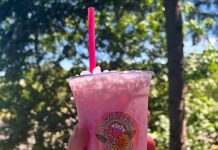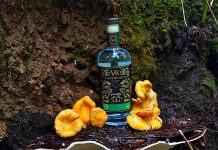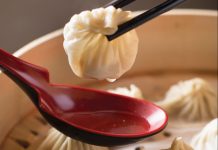Visitors to Thurston County grocery stores in the first half of the 20th century would have spotted an intriguing brand of dairy products, from butter to ice cream, marked “C. C. C.” This was the brand of the Capital City Creamery, a landmark business in Thurston County for more than five decades.
 At the turn of the 20th century, dairy farming was the most important agricultural industry in Thurston County. There were only a handful of commercial creameries throughout the county and most farmers processed their own milk and butter at home. Seeing financial opportunity, the Olympia Chamber of Commerce began in 1898 to lobby for the creation of a creamery in the city. They were soon able to interest Hazen W. Maynard, a creamery operator from the Midwest. He had been considering creating a creamery in Plumb, a small rural community along the railroad south of Tumwater, but the Chamber persuaded him to move to Olympia.
At the turn of the 20th century, dairy farming was the most important agricultural industry in Thurston County. There were only a handful of commercial creameries throughout the county and most farmers processed their own milk and butter at home. Seeing financial opportunity, the Olympia Chamber of Commerce began in 1898 to lobby for the creation of a creamery in the city. They were soon able to interest Hazen W. Maynard, a creamery operator from the Midwest. He had been considering creating a creamery in Plumb, a small rural community along the railroad south of Tumwater, but the Chamber persuaded him to move to Olympia.
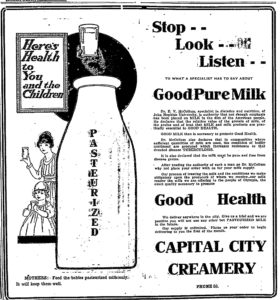
Maynard named his new business the Capital City Creamery and moved into the first floor of a building on the southwest corner of State Avenue and Washington Street. He began production on August 29, 1898, buying raw milk from local farmers to process into butter, ice cream, and other dairy products. The Creamery was one of the first to pasteurize its products, a relatively new process. Initial capacity was estimated at 5,000 pounds of milk (or 250 pounds of butter) per day. Labeling his products as “Try Me,” Maynard sold his goods directly from his store as well as selling them to local grocery stores and peddlers. He also sold DeLaval Cream Separators to dairy farmers, always sure to diversify his market.
In 1911, brothers Ray and Guy Klumb bought the Creamery from Maynard, also purchasing and combing it with the Nesqually (a variant spelling of Nisqually) Creamery, located at the historic Brown Farm on the Nisqually Delta. In 1912, the brothers opened operations in a one-story special-built concrete building at 507 Columbia Street (later renumbered 509 Columbia) that would be the Capital City Creamery’s final home. They even purchased one of the first auto-delivery trucks in Olympia, a used Ford, in 1914.
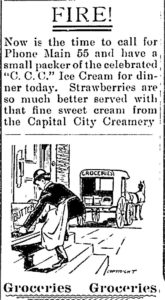
Ray Klumb bought out his brother in 1913. In 1920, John O. Dalquest purchased interest in the creamery and became company president after Klumb retired. H. R. Derrick and his wife Lydia became, respectively, manager and secretary-treasurer. In 1936, the Derricks bought out Dalquest.
By the late 1910s, the Creamery also began to sell ice and ice boxes. Ice boxes were non-mechanical refrigerators that used ice to keep food cool. In 1928, the company sold 34,000 gallons of ice. However, one of their main products was ice cream, which they sold both to drug store soda fountains (such as Rexall) and directly to customers. Ice cream was often eaten at the time in slices. On April 27, 1929, the Daily Olympian newspaper listed the wide variety of ice creams molds used by the Company:
“‘Puss and Boots,’ a chocolate ice cream in the form of a boot with a little white kitten’s head sticking out of the top, is one of the favorites with Olympia kiddies. Old Saint Nicholas, in a quart and a half size, is a prize mold owned by the creamery. The firm also has other Santa Claus models decorated in three colors. Other molds include cakes for birthdays and other occasions, pies, roses, lilies, pumpkins, Easter lilies, cards in ace, king and queen models, cupid in a rose, wedding bells, turkeys, and numerous other designs.”
The Great Depression brought hard times to businesses across Thurston County, including the Capital City Creamery. The company tried to increase its visibility with various activities. These included inviting children to return their signature blue and red milk bottle caps for a penny each. They offered clocks and other products at a discount to customers who brought in a certain number of bottle caps or butter wrappers. They even began to offer cold storage lockers for people to rent so they could store food.
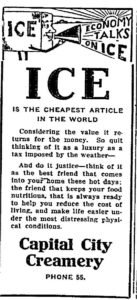
In 1932, the Creamery offered an essay contest, promising the first prize winner a 25-piece set of breakfast dishes. Second place would receive $3.00 worth of their products and thirteen others would get a pound stick of butter. All contestants had to do was write a letter about “Capital City Creamery products and how they help in preparing my menus” and enclose one C. C. C. butter wrapper.
In the late 1940s, the Capital City Creamery was bought out by Theodore Adams and G. W. Burke. The store closed in the early 1950s and its building was later torn down. The site became a parking lot. However, for over half a century the Capital City Creamery was an important part of community and business life. Times change and businesses come and go, but dairy products remain a part of everyday life.





